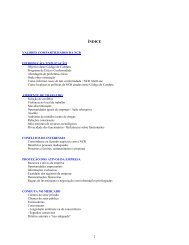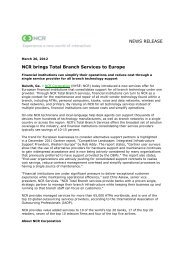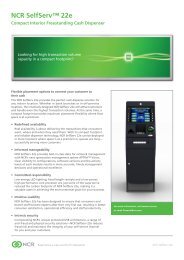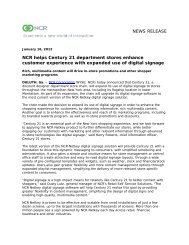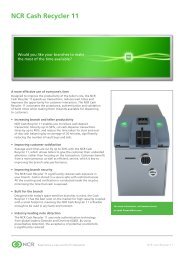Financial Inclusion White Paper - NCR
Financial Inclusion White Paper - NCR
Financial Inclusion White Paper - NCR
You also want an ePaper? Increase the reach of your titles
YUMPU automatically turns print PDFs into web optimized ePapers that Google loves.
Brazil<br />
Brazil’s government has urged state banks to better serve poor<br />
people and reach out to the rural population. To support this<br />
aim, the government has relaxed account opening conditions<br />
and the rules for assigning banking correspondents 4 (BCs) to<br />
deliver financial services. In Brazil, banks need to place 45<br />
percent of sight deposits in reserve at the central bank at 0 percent rate of<br />
interest. To promote micro finance, central bank permits banks to take 2 percent<br />
of the allocated 45 percent deposit and deliver micro loans at between 24 and 48<br />
percent interest rate. This acts as an incentive to reach out to low income<br />
population. Now, as a result of favorable government policy, there are more than<br />
27,000 BCs in Brazil and four banks have acquired a total of eight million new<br />
customers in less than three-and-a-half years.<br />
Kenya<br />
In 2006, the Kenyan government passed The Microfinance Act,<br />
allowing Micro Finance Institutions (MFIs) to take deposits from<br />
May 2008. The Association of Microfinance Institutions of Kenya<br />
(AMFI) considers this act as a platform for MFIs to retain clients<br />
and provide better financial services. The Act addresses licensing<br />
provisions, minimum capital requirements, minimum liquid assets, submission of<br />
accounts to the Central Bank, supervision by the Central Bank, and limits on loan<br />
and credit facilities. It also seeks to protect depositors by mandating deposittaking<br />
MFIs to contribute to the deposit protection fund.<br />
China<br />
China’s central bank, the People’s Bank of China, launched a<br />
pilot in 2006 to stimulate micro-lending to individuals and<br />
companies by township and village banks. Seven domestic<br />
micro-credit corporations were established in five provinces and<br />
two micro-credit corporations were created with assistance from<br />
the International Finance Corp (IFC), a member of the World Bank. After the<br />
success of the pilot, in October 2007 the China Banking Regulatory Commission's<br />
program was expanded nationwide. The program now covers 25 village banks.<br />
India<br />
The government of India’s National Rural <strong>Financial</strong> <strong>Inclusion</strong> Plan<br />
(NRFIP) has set a target to achieve complete financial inclusion<br />
by 2015. The plan aims to serve fifty percent of the financially<br />
excluded (280 mn) population by 2012 through regional and<br />
semi-urban branches of commercial and regional rural banks.<br />
4 Banking Correspondents (BC) or better known as agents represent the bank while delivering financial<br />
services from shared access outlets or during ‘doorstep banking’. The BC may not necessarily be a bank<br />
employee but could be a financial service provider.<br />
8




